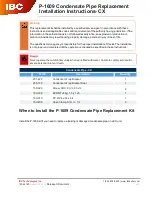
HAMWORTHY HEATING LTD
22
SHAFTESBURY HE
500001049/N
following: Before attempting to commission any
boiler, ensure that personnel involved are aware of
what action is about to be taken and begin by
making the following checks:-
1)
Flueway passages to chimney are clear.
2)
Adequate ventilation as per
Section 7: AIR SUPPLY
exists in the boilerhouse.
3)
The system is fully charged with water, ready to
receive heat. All necessary valves are open and the
pump is circulating water.
4)
The pipework and valve arrangement is installed to
Hamworthy Heating recommendations in such a way
that water flow rates will be in accordance with Figure
3.1.
5)
The gas supply pipework is clear of any loose matter,
tested for soundness and purged to
IGE/UP/1
or
IGE/
UP/1A
as appropriate.
11.4.1 Boiler Checks Prior To Lighting
BEFORE
starting the boiler, check the following:
a.
Check that fuel supply is turned off.
b.
Check that electrical supply is isolated.
c.
Check that electrical installation conforms to the
requirements of these Instructions, the IEE Wiring
Regulations for electrical installations, and any other
local Regulations which apply.
d.
Check boiler castings are undamaged. Remove
access plates to check flue plates are correctly
located in sections, then replace and reseal.
e. Check all thermostat bulbs are correctly inserted
in the appropriate pocket.
f.
Check for water leaks and ensure that both
boiler and heating system is full of water and
properly vented. Check distribution tube is fitted.
g.
Check that all drain cocks are closed, and that all
isolating valves in flow and return pipework are
open.
h.
For OIL
; check that tank(s) have been filled and
oil supply pipework between tank and burner has
been primed.
j.
For GAS
; check soundness of gas installation
and that pipework is purged of air, as detailed in I.
Gas. E. Publications IGE/UP/1 or IGE/UP/1A
respectively.
Check that gas meter is operational and has been
checked by the local region of British Gas.
Check that gas meter and supply pipework is of
sufficient size to meet the input rating of the burner/
boiler. Refer to Section 16.2.
k.
Check that burner output is correct for size of
boiler in question, referring to Figures 11.1, 11.2 &
11.3, and the manufacturer's technical information
supplied with the burner.
Note: - ALL FUELS.
Refer to the commissioning procedure in the
burner manufacturers literature, before firing the
boiler.
Always adjust the fuel supply upwards from a
low position to ensure that a fuel rich mixture is
not achieved.
11.4.2 Oil fired Boilers
a.
Check flexible oil lines are tightly jointed and are
not twisted or kinked to form an obstruction.
b.
Check correct nozzle(s) is fitted to burner,
(Figure 11.4) and that it is tight.
Note:
Some burners
are despatched with a test nozzle(s) fitted. In these
cases, the correct nozzle(s) is despatched in a
separate package with the boiler and MUST be
fitted to the burner before attempting to fire the
boiler.
c.
Check electrodes and ensure porcelain insulation
is not cracked.
d.
Check electrodes are correctly positioned, and
gap is correctly set, as specified in the
manufacturer's technical information supplied with
the burner.
e.
Check blast tube is correctly located, and
securely fastened in place and firebrick at rear of
combustion chamber is sound and correctly located.
f
. Check burner seats correctly onto burner
mounting plate and is securely fastened in place.
g.
Set burner for the required fuel and air
throughputs, as specified in the manufacturer's
technical information supplied with the burner.
h.
Fit a pressure gauge on burner oil pump to check
pump pressure is correctly set.
i.
Check that overheat thermostat manual reset is
set, and that boiler control thermostat and control
system are set to call for heat.
Switch the boiler on and start the burner.
j.
The burner control will first operate the fan to pre-
purge the boiler, then produce an ignition spark and
finally open the oil solenoid valve and the flame
should ignite.
k.
Purge air from oil pump through pressure gauge
port.
IF BURNER LOCKS OUT WAIT 45 SECONDS
BEFORE PRESSING RESET BUTTON ON
BURNER CONTROL BOX.
l.
With burner firing, check the atomising pressure
on gauge and adjust as necessary using the
pressure regulator on burner oil pump. Refer to
technical information supplied with burner.
m.
After allowing burner to reach stable firing
conditions for approximately 15 minutes, carry out
combustion gas check.
Measure CO
2
, CO, smoke number, flue gas
temperature and circulating water temperature rise
across the boiler. The readings obtained should be
as indicated in figure 11.4, target appliance
readings.
Readings should be taken at both High and Low
settings. A link C3-C4 is provided in the control
panel terminals, the removal of which, by pulling out
the terminals, will hold the burner on low fire.
n.
Switch off boiler. Remove oil pressure gauge and
replace sealing plug complete with gasket.
o.
Restart boiler and cycle it on and off several
times to ensure reliable burner ignition and boiler
operation.
















































